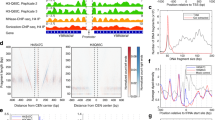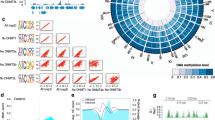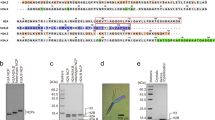Abstract
In eukaryotes, genomic DNA is packaged into the nucleus together with histone proteins, forming chromatin. The fundamental repeating unit of chromatin is the nucleosome, a naturally symmetric structure that wraps DNA and is the substrate for numerous regulatory post-translational modifications. However, the biological significance of nucleosomal symmetry until recently had been unexplored. To investigate this issue, we developed an obligate pair of histone H3 heterodimers, a novel genetic tool that allowed us to modulate modification sites on individual H3 molecules within nucleosomes in vivo. We used these constructs for molecular genetic studies, for example demonstrating that H3K36 methylation on a single H3 molecule per nucleosome in vivo is sufficient to restrain cryptic transcription. We also used asymmetric nucleosomes for mass spectrometric analysis of dependency relationships among histone modifications. Furthermore, we extended this system to the centromeric H3 isoform (Cse4/CENP-A), gaining insights into centromeric nucleosomal symmetry and structure. In this review, we summarize our findings and discuss the utility of this novel approach.




Similar content being viewed by others
References
Beckett D, Kovaleva E, Schatz PJ (1999) A minimal peptide substrate in biotin holoenzyme synthetase-catalyzed biotinylation. Protein Sci 8:921–929
Berndsen CE, Tsubota T, Lindner SE, Lee S, Holton JM, Kaufman PD, Keck JL, Denu JM (2008) Molecular functions of the histone acetyltransferase chaperone complex Rtt109-Vps75. Nat Struct Mol Biol 15:948–956
Biggins S (2013) The composition, functions, and regulation of the budding yeast kinetochore. Genetics 194:817–846
Buchwitz BJ, Ahmad K, Moore LL, Roth MB, Henikoff S (1999) A histone-H3-like protein in C. elegans. Nature 401:547–548
Carrozza MJ, Li B, Florens L, Suganuma T, Swanson SK, Lee KK, Shia WJ, Anderson S, Yates J, Washburn MP, Workman JL (2005) Histone H3 methylation by Set2 directs deacetylation of coding regions by Rpd3S to suppress spurious intragenic transcription. Cell 123:581–592
Chen Y, Baker RE, Keith KC, Harris K, Stoler S, Fitzgerald-Hayes M (2000) The N terminus of the centromere H3-like protein Cse4p performs an essential function distinct from that of the histone fold domain. Mol Cell Biol 20:7037–7048
Cheung P, Tanner KG, Cheung WL, Sassone-Corsi P, Denu JM, Allis CD (2000) Synergistic coupling of histone H3 phosphorylation and acetylation in response to epidermal growth factor stimulation. Mol Cell 5:905–915
Church M, Smith KC, Alhussain MM, Pennings S, Fleming AB (2017) Sas3 and Ada2(Gcn5)-dependent histone H3 acetylation is required for transcription elongation at the de-repressed FLO1 gene. Nucleic Acids Res 45:4413–4430
Dalal Y, Wang H, Lindsay S, Henikoff S (2007) Tetrameric structure of centromeric nucleosomes in interphase Drosophila cells. PLoS Biol 5:e218–e212
Dunleavy EM, Zhang W, Karpen GH (2013) Solo or doppio: how many CENP-As make a centromeric nucleosome? Nat Struct Mol Biol 20:648–650
Foltz DR, Jansen LE, Black BE, Bailey AO, Yates JR, Cleveland DW (2006) The human CENP-A centromeric nucleosome-associated complex. Nat Cell Biol 8:458–469
Furuyama S, Biggins S (2007) Centromere identity is specified by a single centromeric nucleosome in budding yeast. PNAS 104:14706–14711
Furuyama T, Henikoff S (2009) Centromeric nucleosomes induce positive DNA supercoils. Cell 138:104–113
Furuyama T, Codomo CA, Henikoff S (2013) Reconstitution of hemisomes on budding yeast centromeric DNA. Nucleic Acids Res 41:5769–5783
Henikoff S, Ahmad K, Platero JS, van Steensel B (2000) Heterochromatic deposition of centromeric histone H3-like proteins. Proc Natl Acad Sci USA 97:716–721
Henikoff S, Ramachandran S, Krassovsky K, Bryson TD, Codomo CA, Brogaard K, Widom J, Wang JP, Henikoff JG (2014) The budding yeast Centromere DNA Element II wraps a stable Cse4 hemisome in either orientation in vivo. eLife 3:e01861
Howman EV, Fowler KJ, Newson AJ, Redward S, MacDonald AC, Kalitsis P, Choo KH (2000) Early disruption of centromeric chromatin organization in centromere protein A (Cenpa) null mice. Proc Natl Acad Sci USA 97:1148–1153
Ichikawa Y, Connelly CF, Appleboim A, Miller TCR, Jacobi H, Abshiru NA, Chou H-J, Chen Y, Sharma U, Zheng Y, Thomas PM, Chen HV, Bajaj V, Müller CW, Kelleher NL, Friedman N, Bolon DNA, Rando OJ, Kaufman PD (2017) A synthetic biology approach to probing nucleosome symmetry. eLife 6:e1002
Ichikawa Y, Saitoh N, Kaufman PD (2018) An asymmetric centromeric nucleosome. eLife 7:e37911
Jha DK, Strahl BD (2014) An RNA polymerase II-coupled function for histone H3K36 methylation in checkpoint activation and DSB repair. Nat Commun 5:3965
Kato H, Jiang J, Zhou BR, Rozendaal M, Feng H, Ghirlando R, Xiao TS, Straight AF, Bai Y (2013) A conserved mechanism for centromeric nucleosome recognition by centromere protein CENP-C. Science 340:1110–1113
Kato D, Osakabe A, Arimura Y, Mizukami Y, Horikoshi N, Saikusa K, Akashi S, Nishimura Y, Park SY, Nogami J, Maehara K, Ohkawa Y, Matsumoto A, Kono H, Inoue R, Sugiyama M, Kurumizaka H (2017) Crystal structure of the overlapping dinucleosome composed of hexasome and octasome. Science 356:205–208
Krogan NJ, Kim M, Tong A, Golshani A, Cagney G, Canadien V, Richards DP, Beattie BK, Emili A, Boone C et al (2003) Methylation of histone H3 by Set2 in Saccharomyces cerevisiae is linked to transcriptional elongation by RNA polymerase II. Mol Cell Biol 23:4207–4218
Li S, Shogren-Knaak MA (2008) Cross-talk between histone H3 tails produces cooperative nucleosome acetylation. PNAS 105:18243–18248
Li S, Shogren-Knaak MA (2009) The Gcn5 bromodomain of the SAGA complex facilitates cooperative and cross-tail acetylation of nucleosomes. J Biol Chem 284:9411–9417
Li J, Moazed D, Gygi SP (2002) Association of the histone methyltransferase Set2 with RNA polymerase II plays a role in transcription elongation. J Biol Chem 277:49383–49388
Li B, Howe L, Anderson S, Yates JR III, Workman JL (2003) The Set2 histone methyltransferase functions through the phosphorylated carboxyl-terminal domain of RNA polymerase II. J Biol Chem 278:8897–8903
Liokatis S, Klingberg R, Tan S, Schwarzer D (2016) Differentially isotope-labeled nucleosomes to study asymmetric histone modification crosstalk by time-resolved NMR spectroscopy. Angew Chem Int Ed 55:8262–8265
Lo WS, Trievel RC, Rojas JR, Duggan L, Hsu JY, Allis CD, Marmorstein R, Berger SL (2000) Phosphorylation of serine 10 in histone H3 is functionally linked in vitro and in vivo to Gcn5-mediated acetylation at lysine 14. Mol Cell 5:917–926
Luger K, äder M, Richmond AW, Sargent RK, Richmond DF TJ (1997) Crystal structure of the nucleosome core particle at 2.8 Å resolution. Nature 389:251–260
Meluh PB, Yang P, Glowczewski L, Koshland D, Smith MM (1998) Cse4p is a component of the core centromere of Saccharomyces cerevisiae. Cell 94:607–613
Oegema K, Desai A, Rybina S, Kirkham M, Hyman AA (2001) Functional analysis of kinetochoreassembly in Caenorhabditis elegans. J Cell Biol 153:1209–1226
Pai CC, Kishkevich A, Deegan RS, Keszthelyi A, Folkes L, Kearsey SE, De León N, Soriano I, de Bruin RAM, Carr AM, Humphrey TC (2017) Set2 methyltransferase facilitates DNA replication and promotes genotoxic stress responses through MBF-dependent transcription. Cell Rep 20:2693–2705
Palmer DK, O’Day K, Wener MH, Andrews BS, Margolis RL (1987) A 17-kD centromere protein (CENP-A) copurifies with nucleosome core particles and with histones. J Cell Biol 104:805–815
Pattenden SG, Gogol MM, Workman JL (2010) Features of cryptic promoters and their varied reliance on bromodomain-containing factors. PLoS One 5:e12927
Ramachandran S, Zentner GE, Henikoff S (2015) Asymmetric nucleosomes flank promoters in the budding yeast genome. Genome Res 25:381–390
Régnier V, Vagnarelli P, Fukagawa T, Zerjal T, Burns E, Trouche D, Earnshaw W, Brown W (2005) CENP-A is required for accurate chromosome segregation and sustained kinetochore association of BubR1. MolCell Biol 25:3967–3981
Rhee HS, Bataille AR, Zhang L, Pugh BF (2014) Subnucleosomal structures and nucleosome asymmetry across a genome. Cell 159:1377–1388
Rossetto D, Avvakumov N, Côté J (2012) Histone phosphorylation: a chromatin modification involved in diverse nuclear events. Epigenetics 7:1098–1108
Schaft D, Roguev A, Kotovic KM, Shevchenko A, Sarov M, Neugebauer KM, Stewart AF (2003) The histone 3 lysine 36 methyltransferase, SET2, is involved in transcriptional elongation. Nucleic Acids Res 31:2475–2482
Shema E, Jones D, Shoresh N, Donohue L, Ram O, Bernstein BE (2016) Single-molecule decoding of combinatorially modified nucleosomes. Science 352:717–721
Sims RJ, Belotserkovskaya R, Reinberg D (2004) Elongation by RNA polymerase II: the short and long of it. Genes Dev. 18:2437–2468
Smolle M, Workman JL, Venkatesh S (2013) reSETting chromatin during transcription elongation. Epigenetics 8:10–15
Stoler S, Keith KC, Curnick KE, Fitzgerald-Hayes M (1995) A mutation in CSE4, an essential gene encoding a novel chromatin-associated protein in yeast, causes chromosome nondisjunction and cell cycle arrest at mitosis. Genes Dev 9:573–586
Strahl BD, Grant PA, Briggs SD, Sun ZW, Bone JR, Caldwell JA, Mollah S, Cook RG, Shabanowitz J, Hunt DF, Allis CD (2002) Set2 is a nucleosomal histone H3-selective methyltransferase that mediates transcriptional repression. Mol Cell Biol 22:1298–1306
Sullivan KF (2001) A solid foundation: functional specialization of centromeric chromatin. Curr Opin Genet Dev 11:182–188
Tachiwana H, Kagawa W, Shiga T, Osakabe A, Miya Y, Saito K, Hayashi-Takanaka Y, Oda T, Sato M, Park SY, Kimura H, Kurumizaka H (2011) Crystal structure of the human centromeric nucleosome containing CENP-A. Nature 476:232–235
Takahashi K, Chen ES, Yanagida M (2000) Requirement of Mis6 centromere connector for localizing a CENP-A-like protein in fission yeast. Science 288:2215–2219
Venkatesh S, Workman JL (2015) Histone exchange, chromatin structure and the regulation of transcription. Nat Rev Mol Cell Biol 16:178–189
Voigt P, LeRoy G, Drury WJ, Zee BM, Son J, Beck DB, Young NL, Garcia BA, Reinberg D (2012) Asymmetrically modified nucleosomes. Cell 151:181–193
Xiao T, Hall H, Kizer KO, Shibata Y, Hall MC, Borchers CH, Strahl BD (2003) Phosphorylation of RNA polymerase II CTD regulates H3 methylation in yeast. Genes Dev 17:654–663
Xiao H, Wang F, Wisniewski J, Shaytan AK, Ghirlando R, FitzGerald PC, Huang Y, Wei D, Li S, Landsman D, Panchenko AR, Wu C (2017) Molecular basis of CENP-C association with the CENP-A nucleosome at yeast centromeres. Genes Dev 31:1958–1972
Youdell ML, Kizer KO, Kisseleva-Romanova E, Fuchs SM, Duro E, Strahl BD, Mellor J (2008) Roles for Ctk1 and Spt6 in regulating the different methylation states of histone H3 lysine 36. Mol Cell Biol 28:4915–4926
Zhang W, Colmenares SU, Karpen GH (2012) Assembly of Drosophila centromeric nucleosomes requires CID dimerization. Mol Cell 45:263–269
Zhou Z, Liu YT, Ma L, Gong T, Hu YN, Li HT, Cai C, Zhang LL, Wei G, Zhou JQ (2017) Independent manipulation of histone H3 modifications in individual nucleosomes reveals the contributions of sister histones to transcription. eLife 6:e30178
Acknowledgements
This work was supported by NIH grants R01GM100164 (PDK and Oliver J. Rando) and R35GM127035 (PDK).
Author information
Authors and Affiliations
Corresponding author
Additional information
Communicated by M. Kupiec.
Rights and permissions
About this article
Cite this article
Ichikawa, Y., Kaufman, P.D. Novel genetic tools for probing individual H3 molecules in each nucleosome. Curr Genet 65, 371–377 (2019). https://doi.org/10.1007/s00294-018-0910-0
Received:
Revised:
Accepted:
Published:
Issue Date:
DOI: https://doi.org/10.1007/s00294-018-0910-0




